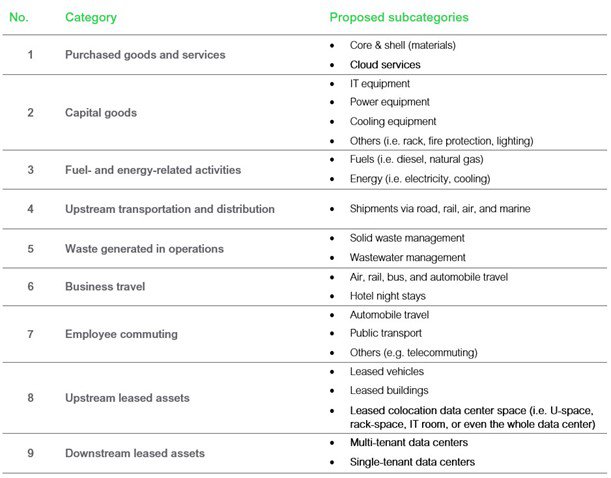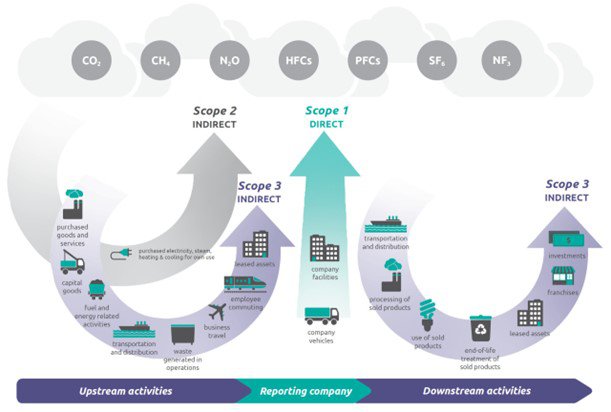Environmental sustainability is a focus for data center operators, so in the fall of 2021, after a year of research, we released White Paper #67, ‘Guide to environmental sustainability metrics for data centers’.
This framework includes five categories with 23 metrics for data center operators in various stages of their sustainability journeys to take control of sustainability goals. Those metrics included Scope 3 GHG (Greenhouse Gas) emissions – the emissions from the value chain.
Currently, the GHG Protocol and most organizations view reporting on Scope 3 emissions as optional, but as more renewable energy is used, Scope 3 carbon is poised to become the most significant contributor to a data center’s overall GHG emissions.
Many data center operators don’t know how to track embodied carbon from their value chain. To make matters worse, the industry didn’t have a data center-relevant framework for Scope 3 accounting and reporting.
Until now.
A new framework on Scope 3 emissions
Robert Bunger and I have developed a new White Paper #53 titled, ‘Recommended inventory for data center Scope 3 GHG emissions reporting’. In the newly-released paper, we propose nine emissions source categories and their data center specific subcategories as a framework for data center operators to account and report their Scope 3 emissions.
Why Scope 3 emissions and why now?
Reporting on Scope 3 emissions is limited compared to Scope 1 and 2 emissions due to several challenges, such as a lack of direct control over value chain activities, a lack of reliable supplier data, and a lack of accounting and reporting methodologies. However, Scope 3 emissions reporting is becoming more and more important for an organization because:
- Omitting Scope 3 emissions may present potential risk for investors. Investors will not be aware of a company’s true exposure to climate risks.
- Accounting for and reporting on Scope 3 emissions will become mandatory in the near future. According to Science-Based Target Initiative (SBTi) criteria, “If a company has significant scope 3 emissions (over 40 percent of total scope 1, 2 and 3 emissions), it should set a scope 3 target.”
The proposed inventory applies to all organizations that depend on IT to run their business. The IT resources can be categorized into three main categories:
- Data center facilities owned and operated by your organization (i.e., on-premise)
- IT equipment housed within a colocation facility
- Cloud services, hosted applications, etc.
Scope 3 fun facts
If you’re new to carbon emissions tracking and the “Scopes”, don’t worry. The GHG Protocol has plenty of resources to get you started. Below is a graphic overview of Scope 1, 2, and 3 emissions.
- Scope 3 emissions are sometimes called emissions from a corporation’s “Value Chain”.
- The term “embodied” carbon is used frequently to describe emissions that occur during the manufacture of a product, and it is a subset of Scope 3.
- There are “upstream” and “downstream” Scope 3 emissions. One company’s downstream emissions would be another company’s upstream. There is overlap between companies in carbon reporting, which is intentional and by design.
- Once an organizational boundary is set, there should not be double counting of Scope 1, 2, and 3 emissions within a company. Did you know that the emissions from a data center’s standby diesel generators’ fuel purchase and use have both a Scope 1 and Scope 3 component? The emissions from the generator exhaust during operation is Scope 1, and when you purchase the diesel fuel there’s a Scope 3 component from the extracting, refining, and delivering of this fuel.
Get started
To achieve net zero goals, data center operators need to start tracking Scope 3 emissions, and the proposed inventory in White Paper 53 will get you started and help in reporting, benchmarking, and most importantly, reducing emissions.
More from Schneider Electric
-

DCD>Talks the net-zero journey with Nancy Novak, Compass Datacenters
We discuss how the data center industry will reach net-zero in this DCD>Talk from Schneider Electric's innovation day with Nancy Novak of Compass Datacenters
-

DCD>Talks sustainability: the moment is now with Aamir Paul, Schneider Electric
In this DCD>Talk from the Schneider Electric Innovation day, we sit down with Aamir Paul to talk about the immediate issue of sustainability
-

Innovations: For a sustainable world
An eBook exploring the innovations our industry needs to improve its sustainability



